95d007440aad13ea1bd5194d3efa6dfe.ppt
- Количество слайдов: 79

Nuclear Weapons 101


“The nuclear bomb is the most anti-democratic, antihuman, outright evil thing that man has ever made… This world of ours is four thousand, six hundred million years old. It could end in an afternoon. ” Walter Herdeg Arundhati Roy

INESAP & NAPF, 2002 The Current State of Nuclear Weapons

Nuclear weapons today • Between 21, 300 and 30, 000 nuclear warheads with the equivalent explosive force of: – 200, 000 Hiroshima-sized bombs (11 billion tons of TNT - 2 tons for every human on the planet). • 5, 000 ready to be launched in less than 30 minutes.

Tactical vs. strategic nuclear weapons • Tactical: – US and Russian definition - less than 500 km range. • Strategic: – Intended to be detonated in other countries, i. e. intercontinental delivery.

Nuclear weapons -Declared states Strategic Tactical USA 7, 000 3, 300 Russia 6, 000 14, 000 France 450 60 China 400 150 Britain 185 80

Nuclear weapons “Undeclared” states Israel - 200 India - 60 -80 Pakistan - 10 -25

Mass destruction abilities • 40+ states are nuclear capable. • Chemical and biological weapons are the “poor man’s” Weapons of Mass Destruction.

Missile Defense • A proposed US system to shoot down long-range ballistic missiles in flight. • $90 billion spent since 1983. • $60 -100 billion more estimated by the Clinton Administration. – Same amount could eradicate six common diseases that kill 40, 000 third world children every day.

Missile Defense • The US intends to withdraw from the 1972 Anti-Ballistic Missile (ABM) Treaty on June 13, 2002. – The ABM prohibits deployment of a missile defense system giving one side a strategic advantage. • Breaking the ABM undermines the Non Proliferation Treaty

Canada and Missile Defense • “Canadian participation in the Missile Defense shield is more about maintaining good relations with the US than it is about protecting Canada. ” – Will Canada participate in MD? – What will Canada have to pay?

US Nuclear Posture Review • 2002 report on the goals and structure of US nuclear forces. • Asserted a permanent role for nuclear weapons in military policy into the future. – Goes against treaty commitments for nuclear weapons elimination. • Firmly committed to Missile Defense.

Robert Del Tredici Vulnerability of nuclear facilities? Nuclear Terrorism

Nuclear terrorism Nuclear weapons materials are vulnerable to terrorists in many different countries because production and storage facilities are not adequately safeguarded.

Nuclear terrorism • A crude but highly lethal nuclear device can be fabricated by a determined group if it can acquire quantities of highly enriched uranium or plutonium. • Acquisition of fissile material by terrorists is a very real possibility.

Nuclear material availability • Fissile materials are not controlled or accounted for effectively. • Only 1/3 of an estimated 600 tonnes of weapons-usable material in the former Soviet Union has been locked up. – At least 40 kg of weapons-usable uranium and plutonium has been stolen.

Terrorism and nuclear energy • The International Atomic Energy Agency has confirmed that current nuclear power plants are structurally vulnerable against the Sept. 11 attack scenario. • “Consequences of a direct hit from an airliner would be catastrophic. ” • There is also virtually no protection from the sabotage acts of an insider.

The Basics Oxford University Press

Nuclear weapon cores • Fission weapons require “fissile isotopes”. • Most important - plutonium-239 (Pu-239) and uranium-235 (U-235). • Some weapons are made from both isotopes. • Basic nuclear weapons rely on nuclear fission chain reaction to produce large amount of energy in a very short time.

Nuclear explosions • Explosive power measured by the mass equivalent of TNT: – A 1 kiloton bomb has an explosive yield equivalent to 1000 tons of TNT. – A 1 megaton bomb has an explosive yield equivalent to 1, 000 tons of TNT. – The Hiroshima bomb was 15 kilotons.

Plutonium • Weapons grade - produced in military plutonium-production reactors specifically for nuclear weapons use. • Reactor grade - produced in commercial nuclear-power reactors – For electricity production, but can be used to make weapons.

Plutonium - environmental impact • Production of a single kg of plutonium produces: – 1, 300 L of high-level radioactive waste. – 200, 000 kg of low to intermediate-level waste. – 10 million L of contaminated cooling water. • The half-life of plutonium is 24, 000 years. Sygma

Uranium • Naturally occurring uranium contains 0. 7% U-235. • Weapons use highly-enriched uranium (HEU) - proportion of U-235 increased. • Weapons grade - usually enriched to greater than 90%, but lower percentages still useable.

Estimated plutonium stocks Country Former SU US UK France China Israel India Japan Germany Military plutonium Civil plutonium 125 tons 110 tons 6 tons 40 tons < 8 tons 50 tons 80 tons 2 tons 950 kg 200 -300 kg - < 8 tons 50 tons 40 tons

Estimated HEU stocks Country Former SU US UK France China Pakistan South Africa Military highlyenriched uranium 1, 000 tons 700 tons 150 kg 360 kg

Core requirements • A 20 kt nuclear bomb requires: – 4 -5 kg of weapons grade plutonium OR – 10 -15 kg of weapons grade uranium. • A 1 kt nuclear weapon could be made with: – 1 kg of weapons-grade plutonium OR – 2. 5 kg of weapons-grade uranium.

Delivery of nuclear weapons • Launched from submarines or land. • Delivered on artillery or ballistic or cruise missiles. • Dropped from aircraft. • Low technology such as trucks, small boats and cargo planes could also be used. • A 1 or 2 kt device could be carried in a backpack.

Akira Yokoyama & Yusako Kamekura The Effects of Nuclear Weapons

Nuclear testing • 2, 045 nuclear test explosions by 8 countries. • Estimated 49, 000 deaths from radioactive fallout from testing in Nevada. • Testing in the South Pacific has left islands uninhabitable and ruined for agriculture. – Islanders forced to leave their homes. Library of Congress

August 6, 1945 • US detonated a 15 kiloton bomb over Hiroshima, Japan. Sygma Pantheon Books, 1981 • Deaths - 118, 661. • Injuries - 78, 000.

August 9, 1945 • US detonated a 21 kiloton bomb over Nagasaki, Japan. • Deaths - 73, 884. • Injuries - 74, 909. • 6. 7 million square metres leveled. Somerville House Books, Ltd.

Hiroshima and Nagasaki UPI/Bettmann • Ground temperatures reached about 7, 000 degrees. Peacewire • “Black rain” containing radioactive fallout poured down for hours after the explosions.

Effects of a 12 kiloton bomb New York City Band Distance from Ground Zero Area Average population Fatality rate Total deaths A 0 -0. 5 km 0. 8 sq km 6, 603 98% 6, 471 B 0. 5 -1. 0 km 2. 3 sq km 18, 985 90% 17, 086 C 1. 0 -1. 5 km 4. 0 sq km 33, 017 46% 15, 188 D 1. 5 -2. 0 km 5. 65 sq km 45, 398 23% 10, 441 E 2. 0 -5. 0 km 65. 9 sq km 543, 952 2% 10, 879

One-megaton bomb detonated in the air • Flash – Intense flash of light, a thousand times brighter than lightning. – Pulse of heat radiation - sets fire to combustible material 14 km away. – Pulse of X-rays, lethal within 3 km.

One-megaton bomb detonated in the air • Fireball – Forms after the ‘flash’ and rises in the air. – Can permanently blind people up to 80 km away. – All exposed body parts burned deeply within 10 km. – Superficial burns within fifteen km.

One-megaton bomb detonated in the air • Blast – Powerful blast wave - starts immediately, but travels slower than the flash and fireball. – Destroys everything within 2 km. – 100% fatalities within 3 km. – 50% of people killed within 8 km. – Major damage to buildings within 14 km, windows broken out to 20 -30 km.

One-megaton bomb detonated in the air • Blast – Hurricane force winds, first outwards, then inwards. – Tornado force winds (six hundred km/hr), within four km - can drive glass splinters into people. – People picked up and hurled into any object strong enough to be still standing.

One-megaton bomb detonated in the air • Firestorm – Fires started by the first flash coalesce. – Cause sufficient updraft to form their own wind, which blows inwards from all sides - increasing the intensity of the fire. – Fire uses all available oxygen. – “People caught in the open would melt, those in shelters would probably be baked. ”

One-megaton bomb detonated in the air • Acute radiation exposure – Central nervous system dysfunction. – Gastrointestinal damage. – Uncontrolled internal bleeding. – Bleeding from gums or within the skin. – Massive infections. – Death.

One-megaton bomb detonated in the air • Delayed radiation – Everything in vicinity of explosion radioactive. – Hiroshima - radioactive rainstorms. – 1/3 of original fissile material not destroyed. – Widespread contamination. – Increased risk of developing cancer for survivors.

One-megaton bomb detonated in the air • Firestorm – Fires started by the first flash coalesce. – Cause sufficient updraft to form their own wind, which blows inwards from all sides - increasing the intensity of the fire. – Fire uses all available oxygen. – “People caught in the open would melt, those in shelters would probably be baked. ”

One-megaton bomb detonated in the air • In case of a nuclear bomb - don’t bother to call your doctor. – No significant medical response possible. – Hospitals destroyed, most health care providers killed.

One-megaton bomb detonated in the air • Medical response barriers – No electricity, water or telephone service. – No drugs, sterile IV solutions, bandages. – Impassable roads, inaccessible areas. – Overloading of emergency/ hospital services in surrounding areas. – Rescuers risk radiation exposure.

One-megaton bomb detonated in the air • Medical problems: one city of 1 -2 million – Fifty times more severe burns than burn beds in North America. – A year’s supply of blood for transfusions needed immediately. – Bottlenecks and delays due to the need for radioactivity assays. – Most of injured die, even from easily treated injuries.

One-megaton bomb detonated at ground-level • Enormous crater - 400 metres wide and 70 metres deep. • Major fallout of radioactive particulates, potentially lethal hundreds of kilometres downwind. • Area of blast damage and immediate deaths about one half of air detonation scenario. • More deaths days to weeks after bomb due to radiation sickness from fallout.

1 megaton bomb over Ottawa Public Broadcasting Service

Effect of nuclear war • Many nuclear bombs exploded. • End of civilization in countries concerned. • Radioactive contamination of whole continents. • Permanent large scale damage to environment. • Nuclear winter.

Nuclear winter • Airborne contaminants absorb and reflect the sun’s rays. • Results in an extended period of semi -darkness and freezing temperatures. • Potentially generated from less than 100 detonations.

Disarmament and Security Centre International Law and Treaties The World Court

International law and nuclear disarmament • International law regime relating to nuclear weapons is still developing. – Current treaties focus on reducing arms and preventing proliferation. – None expressly ban nuclear weapons universally and provide for nuclear disarmament.

Anti-Ballistic Missile Treaty (ABM) - 1972 • Agreement between the US and USSR. • Both promise to establish no more than one ABM site on their national territory. • Bans the testing, development and deployment of sea-, air-, space- and mobile land-based missile defense systems.

Non-Proliferation Treaty (NPT)- 1968 • Cornerstone of the global disarmament regime. • 187 states are parties – India, Pakistan, Israel and Cuba not parties. • Two-part bargain between nuclear weapon states (NWS) and non-nuclear weapon states (NNWS).

Non-Proliferation Treaty • Article I – Nuclear weapons states undertake not to transfer nuclear explosive devices nor to encourage or assist non-nuclear weapons states to acquire or manufacture nuclear explosive devices. • Article VI - Obligate the nuclear weapon states to pursue negotiations to eliminate their arsenals.

Non-Proliferation Treaty • Article II – Non-nuclear weapon states undertake not to receive, acquire or manufacture nuclear explosive devices.

NPT 2000 Review • States committed to “An unequivocal undertaking … to accomplish the total elimination of their nuclear arsenals …” • All parties to the NPT 2000 Review Conference agreed to 13 Practical Steps for Nuclear Disarmament.

13 practical steps 1. 2. 3. 4. 5. 6. 7. Signing the CTBT Stopping Testing Negotiation No Going Back Abolishing Nukes Implementing Existing Treaties

13 practical steps 8. Implementing Existing Treaties 9. Step by Step… 10. Stopping the Production of Plutonium 11. General and Complete Disarmament 12. Reporting 13. Verifying WILPF

Strategic Arms Reduction Treaties (START) • START I - signed in 1991. – US and Russia agreed to reduce arsenals 50% by 1998 (completed 2001). • START II - signed in 1993. • US and Russia discussing new agreements that may supercede START II.

Comprehensive Test Ban Treaty • • 1996 - Signed by 150 countries. India and Pakistan have not signed. 20 countries have ratified. The US continues to oppose ratification as stated in their recent Nuclear Posture Review. • This treaty bans all nuclear explosions, including "peaceful nuclear explosions".

Conference on Disarmament • The sole multilateral body responsible for the negotiation of international treaties relating to disarmament. • Established in 1979. • 66 countries are members. • Based in Geneva, Switzerland.

Nuclear Weapons Convention (NWC) • A coordinated multilateral effort and genuine commitment to disarmament is needed. • NWC - An agreement on the prohibition of nuclear weapons and a plan for their elimination.

Model NWC, 1997 • Model NWC - submitted by Costa Rica to the United Nations as a discussion draft in 1997. • Prohibits development, testing, production, stockpiling, transfer, use, and threat of use of nuclear weapons. • NWS required to destroy their arsenals according to a series of phases.

International Court of Justice Advisory Opinion, July 8, 1996: “. . . the threat or use of nuclear weapons would generally be contrary to the rules of international law applicable in armed conflict, and in particular the principles and rules of humanitarian law. ”
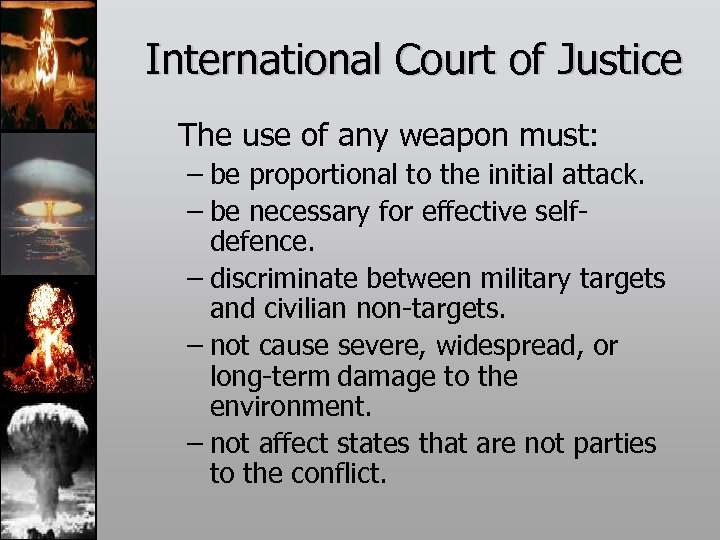
International Court of Justice The use of any weapon must: – be proportional to the initial attack. – be necessary for effective selfdefence. – discriminate between military targets and civilian non-targets. – not cause severe, widespread, or long-term damage to the environment. – not affect states that are not parties to the conflict.

International Court of Justice - Implications Use of any existing nuclear weapons would not be in compliance with international humanitarian law. However, NWS continue to rely on nuclear weapons as fundamental to their national security policies.

Achievements Kome & Crean, 1986 • Limited Test Ban Treaty (1963). – Resulted from mass movements of public opinion. – Doctors collected evidence of strontium-90 in children’s teeth. • Arsenal reductions. Women Strike for Peace, 1960 – 1986 -2001 total weapons warheads decreased by more than 50%.

Achievements - Nuclear free zones • Treaties completely banning nuclear explosive devices in territories. – Latin America – South Pacific – Antarctica – Africa – South East Asia • Proposed zones for Central Asia, Central Europe and the Middle East.

Public opinion on Canada’s role • A 1998 Canada-wide poll asked: “Do you agree that Canada should take a leadership role in global negotiations to eliminate nuclear weapons? ” – 93% agreed. – 6% disagreed. – 1% were undecided.

Public opinion in the US • A 1997 poll asked Americans: “Do you agree that the US should negotiate an agreement to eliminate nuclear weapons? ” – 87% agreed. – 10% disagreed. – 3% were undecided.

Three for All, 2002 Peace March in San Francisco - April 20, 2002
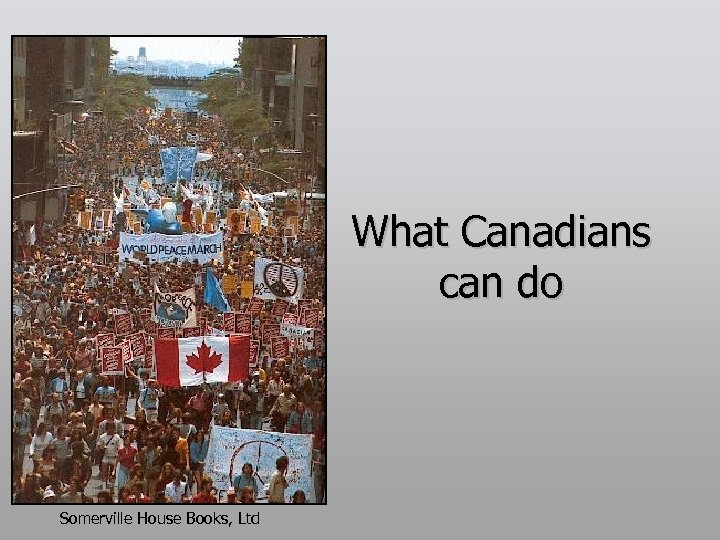
What Canadians can do Somerville House Books, Ltd
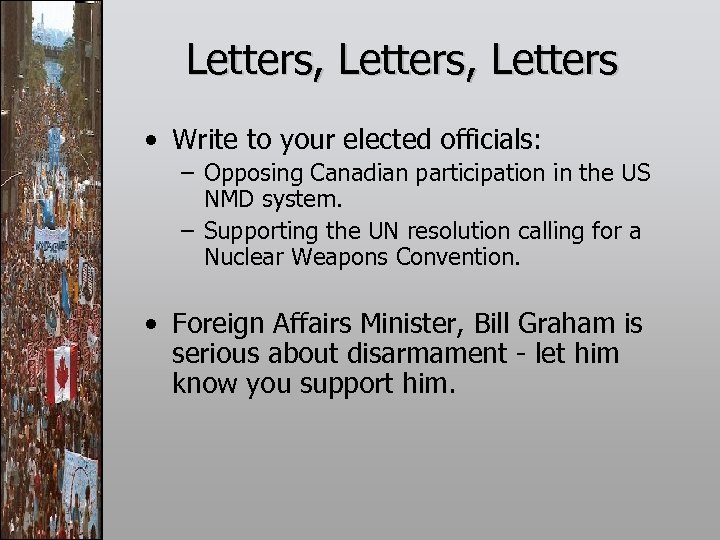
Letters, Letters • Write to your elected officials: – Opposing Canadian participation in the US NMD system. – Supporting the UN resolution calling for a Nuclear Weapons Convention. • Foreign Affairs Minister, Bill Graham is serious about disarmament - let him know you support him.
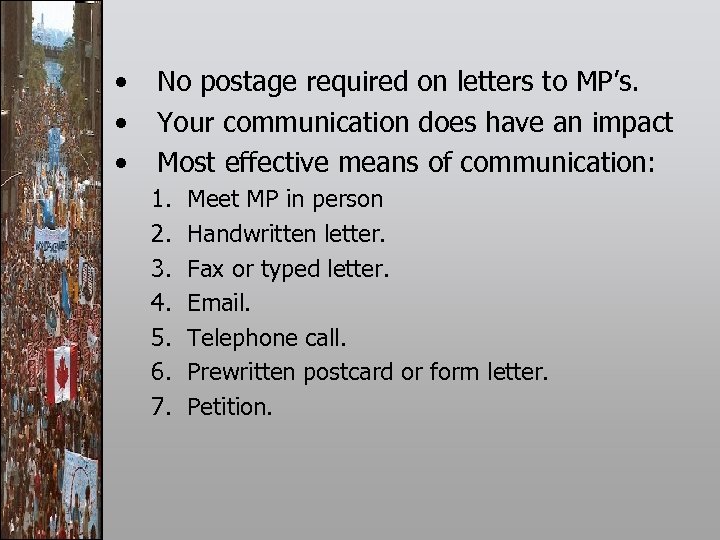
• • • No postage required on letters to MP’s. Your communication does have an impact Most effective means of communication: 1. 2. 3. 4. 5. 6. 7. Meet MP in person Handwritten letter. Fax or typed letter. Email. Telephone call. Prewritten postcard or form letter. Petition.
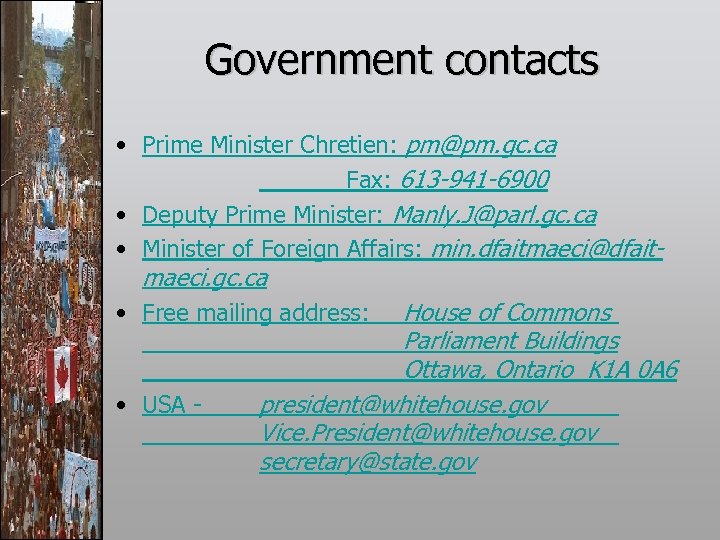
Government contacts • Prime Minister Chretien: pm@pm. gc. ca Fax: 613 -941 -6900 • Deputy Prime Minister: Manly. J@parl. gc. ca • Minister of Foreign Affairs: min. dfaitmaeci@dfaitmaeci. gc. ca • Free mailing address: House of Commons Parliament Buildings Ottawa, Ontario K 1 A 0 A 6 • USA president@whitehouse. gov Vice. President@whitehouse. gov secretary@state. gov
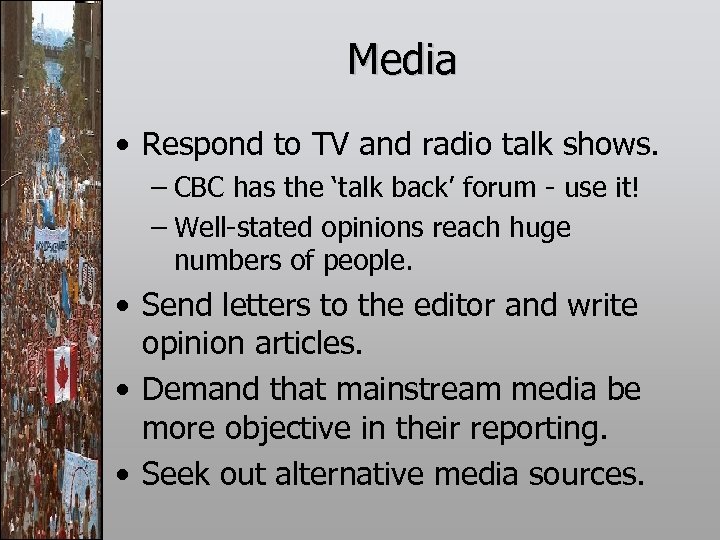
Media • Respond to TV and radio talk shows. – CBC has the ‘talk back’ forum - use it! – Well-stated opinions reach huge numbers of people. • Send letters to the editor and write opinion articles. • Demand that mainstream media be more objective in their reporting. • Seek out alternative media sources.
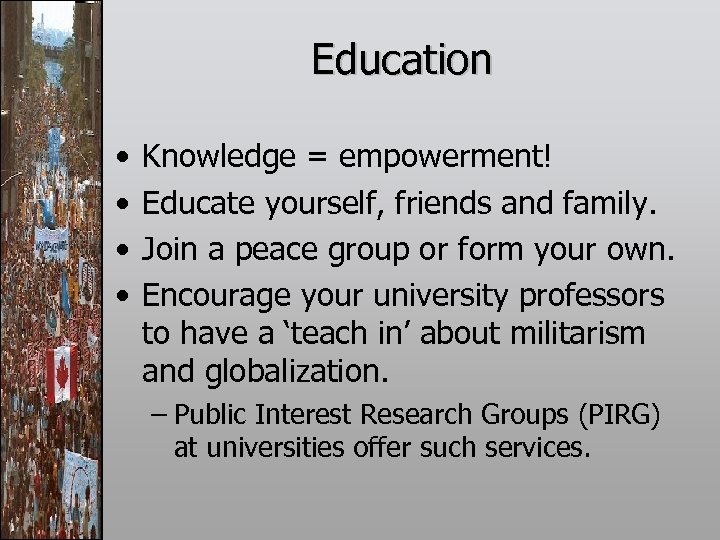
Education • • Knowledge = empowerment! Educate yourself, friends and family. Join a peace group or form your own. Encourage your university professors to have a ‘teach in’ about militarism and globalization. – Public Interest Research Groups (PIRG) at universities offer such services.
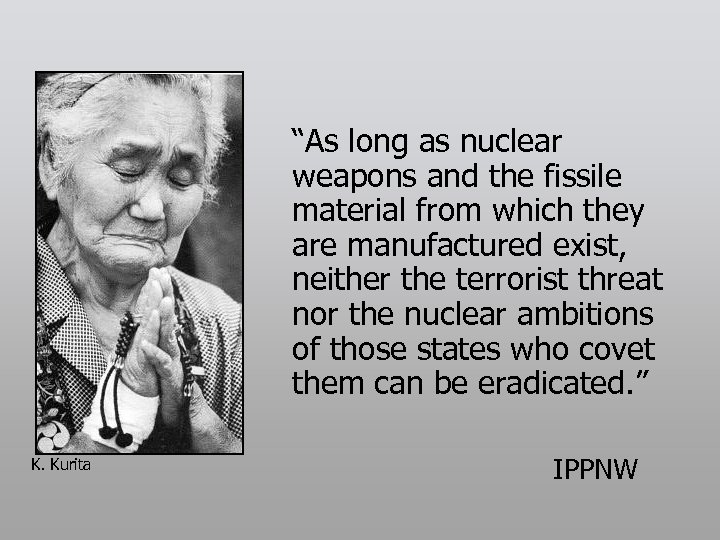
“As long as nuclear weapons and the fissile material from which they are manufactured exist, neither the terrorist threat nor the nuclear ambitions of those states who covet them can be eradicated. ” K. Kurita IPPNW
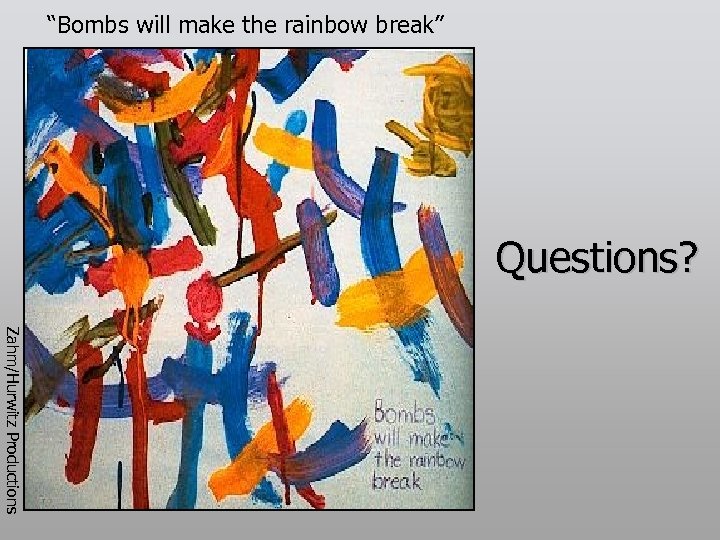
“Bombs will make the rainbow break” Questions? Zahm/Hurwitz Productions
95d007440aad13ea1bd5194d3efa6dfe.ppt